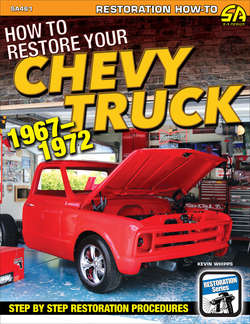Читать книгу How to Restore Your Chevy Truck - Kevin Whipps - Страница 8
На сайте Литреса книга снята с продажи.
ОглавлениеINTRODUCTION
This is the second time I’ve written this book.
Okay, that’s not entirely correct. It’s kind of the third. I should probably explain.
A few years back, CarTech approached me to write this book, and I signed a contract to do so. And after producing roughly half of it, I hit a wall: I had no more contacts to reach out to, no more places to go, and no trucks to photograph. After struggling with it for a bit, I spoke to my editor and we decided to shift directions. I would write How to Restore Your Chevy Truck: 1973–1987, which is exactly what I did.
But when it was all done, I felt a little bit differently about the 1967–1972 book. By then I had tons of contacts, plus there was all the work I had done already, and it’s not like any of that was wasted time. And then there’s the other thing: I love these trucks.
I’ve owned quite a few Chevys in my day—not as many as some of my friends, but a bunch nonetheless. And one of the ones that got away was my 1969 C10 long-bed. It was the original reddish orange with a three-on-the-tree transmission that was routed backward, and it would never pass emissions. But I remember laying on the street with my neighbor, Crazy-Eyed Phil (it’s a long story), tearing it down and figuring it out. I loved that truck, but since I needed a driver and it was never going to be that with the money and time I had back then, I traded it off for another vehicle. I’ve regretted it ever since.
Because of that, 1967–1972 trucks are always in my radar. I check Craigslist for listings all the time, just to see what kind of options are out there. These trucks are popular. There was a period in the mid-aughts where everyone I knew was snatching them up to turn them into some kind of project, and a few of my buddies have even started businesses based on that bodystyle alone. As a result, the trucks became expensive, which put them out of reach for all but a few.
That’s how it was for a few years, but then things started to shift. The trend moved slightly toward the “squarebody” trucks, the 1973–1987s. Prices on the 1967–1972s were and are still competitive, but not quite at the exorbitant rates that they were back in 2006.
Now that’s not to say that they’re cheap. Around my parts (Arizona), finding a short-bed in any kind of decent shape for under $5,000 is like finding a unicorn with hen’s teeth. People who are selling these trucks tend to know what they have and price them accordingly. And the ones that are affordable get swept up quickly by guys like me who know a steal when they see it. The point is that if you want one of these trucks, you’re either going to need a bit more cash to start, or you’re going to have to adjust your expectations.
So why would you put yourself through the drama then? After all, if you can’t get these trucks without breaking the bank, why would you do it?
Oh man, there are so many reasons.
Well first off, it may not be that bad for you, depending on your situation. Let’s go back to the idea of adjusting your expectations. Having a factory short-bed truck is nice. But the fact is that they’re getting harder and harder to find. However, if you’ve picked up this book, then you’re going to be tearing into a truck anyway. Why not buy a long-bed and turn it into a shorty? The thing is that it’s not that difficult to do with a long-bed in decent shape. And if it’s not—or you don’t want to tackle the metalwork—then you can buy entire reproduction beds for anywhere from $1,500 on up. And if you saved money on the truck because it was a long-bed, then you’re ahead of the game.
Second, these trucks are undeniably cool. And because of their relative scarcity, if you’ve ever had one of them on your bucket list to build, then you might want to do it now. It’s been more than 50 years since the bodystyle was introduced, and they ain’t making any more of them. Get in on the look now while you can, or you might regret it later.
But the most important reason is that an argument can be made that these trucks are the holy grail of Chevy trucks. The 1947–1955 (1st series) long held the crown, and although the 1955–1959s are cool (and I’m partial to the 1973–1987s), everyone wants a 1967–1972. And if you want to whittle it down even further, they all want a 1967 with the big back window, usually in blue (or maybe orange).
But it all starts right here with this book, and I thank you for picking it up. Inside you’re going to find all the answers you need for starting your next big project and turning it into the one of your dreams. There’s a lot of info in here for sure, and it’s very much focused on the restoration process, complete with step-by-step projects that will walk you through every part. It’s the kind of in-depth guide that you won’t find anywhere else, and that’s cool.
As for me, I have yet to find my perfect 1967 short-bed, big back window truck, but I have my eyes on a 1968 stepside that would be pretty cool. Or maybe I’ll pick up that relatively cheap 1970 that I found on Craigslist the other day—or convince my neighbor to sell his 1967 long-bed.
Whichever one I choose, this time I won’t let it get away.
